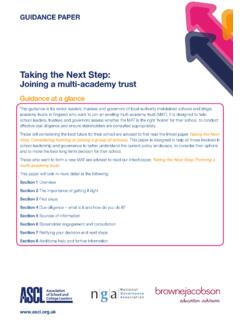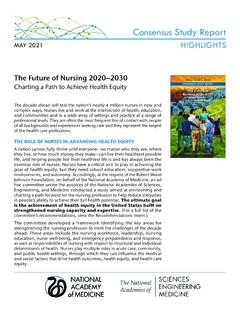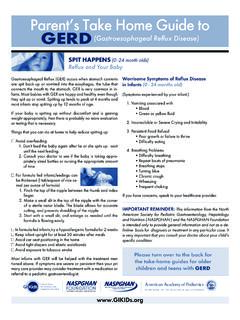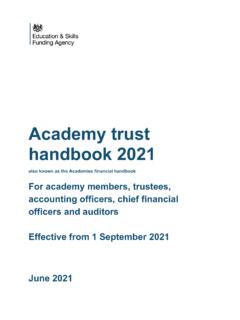Transcription of BIRTH TO 5: WATCH ME THRIVE! - Centers for Disease …
1 1 BIRTH TO 5: WATCH ME thrive ! A COMPENDIUM OF SCREENING MEASURES FOR YOUNG CHILDREN US DEPARTMENT OF HEALTH AND HUMAN SERVICES MARCH 2014 BIRTH to 5: WATCH Me thrive ! A Compendium of Screening Measures for Young Children Acknowledgments We would like to acknowledge the work of the Office of the Deputy Assistant Secretary for Early Childhood Development and the Office of Planning, Research, and Evaluation (OPRE) within the Administration for Children and Families, Department of Health and Human Services who provided the vision and support for this project. The background, summary tables, profiles of individual screening tools, and appendices in t his report were prepared under OPRE s Child Care and Early Education Policy and Research Analysis and Technical Expertise Project with Child Trends (contract #GS10F0030R).
2 For the complete technical report of this work, see: Moodie, S., Daneri, P., Goldhagen, S., Halle, T., Green, K., & LaMonte, L. (2014). Early childhood developmental screening: A compendium of measures for children ages BIRTH to five (OPRE Report 201411). Washington, DC: Office of Planning, Research and Evaluation, Administration for Children and Families, Department of Health and Human Services. The quality parameters, which were used to identify the particular screening instruments included in this report, were set by the federal partners of the BIRTH to Five: WATCH Me thrive ! effort, including the Administration for Children and Families, Administration for Community Living, Centers for Disease Control and Prevention, Centers for Medicaid and Medicare, Health Resources and Services Administration, Eunice Kennedy Shriver National Institute of Child Health and Human Development, and Substance Abuse and Mental Health Services Administration at the US Department of Health and Human Services as well as the Office of Special Education Programs at the US Department of Education.
3 Table of Contents BIRTH to 5: WATCH Me thrive ! ..1 Background .. 2 Summary Tables .. 9 General Information about Screeners .. 10 Screeners: Evidence of Reliability and Validity .. 13 Screeners: Evidence of Reliability and Validity for Different Languages and Different Populations .. 14 Profiles of Individual Measures: Developmental Screeners .. 15 Ages and Stages Questionnaire 3rd Edition .. 16 Ages and Stages Questionnaire Social-Emotional .. 25 Brigance Screens ..34 Developmental Assessment of Young Children Second Edition .. 43 Early Screening FirstSTEp Screening Test for Evaluating Preschoolers.
4 61 Learning Accomplishment Profile Diagnostic 70 Parents Evaluation of Developmental Status .. 78 Parents Evaluation of Developmental Status Developmental Milestones .. 87 Profiles of Individual Measures: Abbreviated Profiles .. 96 Infant Development Survey of Well-Being of Young Children ..100 Appendix A: Glossary of Terms .. 104 Appendix B: Psychometric Documentation and Rationale .. 109 BIRTH to 5: WATCH Me thrive ! Recent statistics indicate that as many as 1 in 4 children, ages 0-5, are at moderate or high risk for developmental, behavioral, or social As a result, the Administration for Children and Families, Administration for Community Living, Centers for Disease Control and Prevention, Centers for Medicaid and Medicare, Health Resources and Services Administration, Eunice Kennedy Shriver National Institute of Child Health and Human Development.
5 And Substance Abuse and Mental Health Services Administration at the Department of Health and Human Services as well as the Office of Special Education Programs at the Department of Education have partnered to launch BIRTH to Five: WATCH Me thrive !, a coordinated effort to encourage developmental and behavioral screening and support for children, families, and the providers who care for them. BIRTH to 5: WATCH Me thrive ! seeks to: Celebrate milestones. Every family looks forward to seeing a child s first smile, first step, and first words. Regular screenings with the support of early childhood providers help raise awareness of a child s development, making it easier to expect and celebrate developmental milestones.
6 Promote universal screening. All of our children need support in the early years to make sure they stay healthy and happy. Just like hearing and vision screenings assure that children can hear and see clearly, developmental and behavioral screenings assure that children are making developmental progress, in areas such as language, social, or motor development. Screening is a regular part of growing up. Identify possible delays and concerns early. Screenings can help kids succeed in and beyond their school years. With regular screenings, families, teachers, and other professionals can assure that young children get the services and supports they need, as early as possible to help them thrive alongside their peers.
7 Enhance developmental supports. Families are children s first and most important teachers. Combining the love and knowledge families have of their children with tools, guidance, and tips recommended by experts, can help optimize the developmental support children receive. The purpose of this compendium is to identify a set of first line screening tools that meet certain quality parameters set by the aforementioned federal partners. Building on a broader technical review of screening tools by Child Trends, Early childhood developmental screening: A compendium of measures for children ages BIRTH to five2, the federal partners identified 11 screening tools that met the following quality criteria: (a) tool accuracy (sensitivity and specificity of and above), (b) inclusion of family input, and (c) inclusion of the social and emotional domain of development.
8 We believe these aspects of quality are important considerations to ensure responsible screening practices. Programs should not interpret this list as recommending or requiring the use of a particular tool. Rather, it should be used to learn about a selection of screening tools that are supported by research and to help make informed decisions about best fit for programs or practices. We hope you find BIRTH to 5: WATCH Me thrive ! helpful in supporting young children and their families on their developmental journey. Visit for a complete set of resources. 1 National Survey of Children s Health, 2011-12.
9 With funding and direction from MCHB, these surveys were conducted by the Centers for Disease Control and Prevention s National Center for Health Statistics. 2 Moodie, S., Daneri, P., Goldhagen, S., Halle, T., Green, K., & LaMonte, L. (2014). Early childhood developmental screening: A compendium of measures for children ages BIRTH to five (OPRE Report 2014-11). Washington, DC: Office of Planning, Research and Evaluation, Administration for Children and Families, Department of Health and Human Services. 1 Background For children age BIRTH to five, physical, cognitive, linguistic, and social-emotional growth and development occur at a rapid pace.
10 While all children in this age range may not reach developmental milestones ( , smiling, saying first words, taking first steps) at the same time,3 development that does not happen within an expected timeframe can raise concerns about developmental disorders, health conditions, or other factors that may negatively impact the child s Early, frequent screening5 of young children for healthy growth and development is recommended to help identify potential problems or areas needing further evaluation. By catching developmental issues early, children can be provided with treatment or intervention more effectively, and additional developmental delays or deficits may be For developmental screening to be effective, it should begin early in a child s life; be repeated throughout early childhood.


















